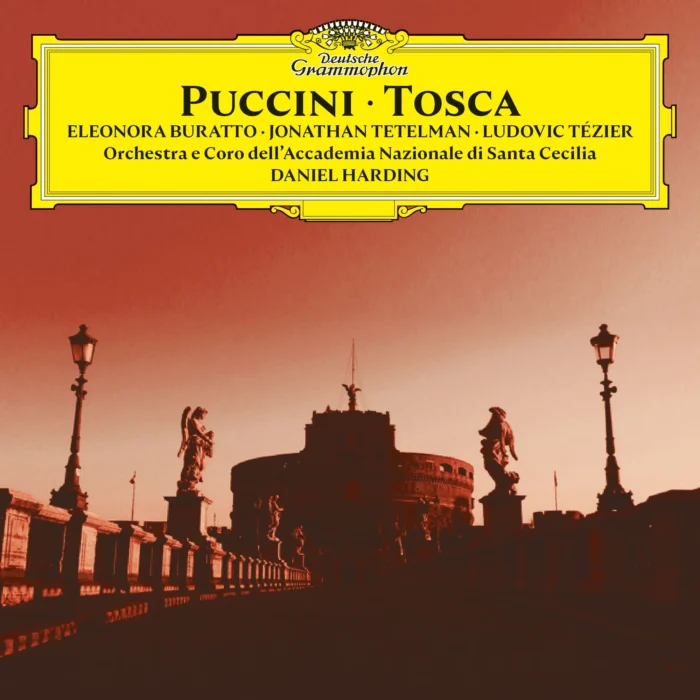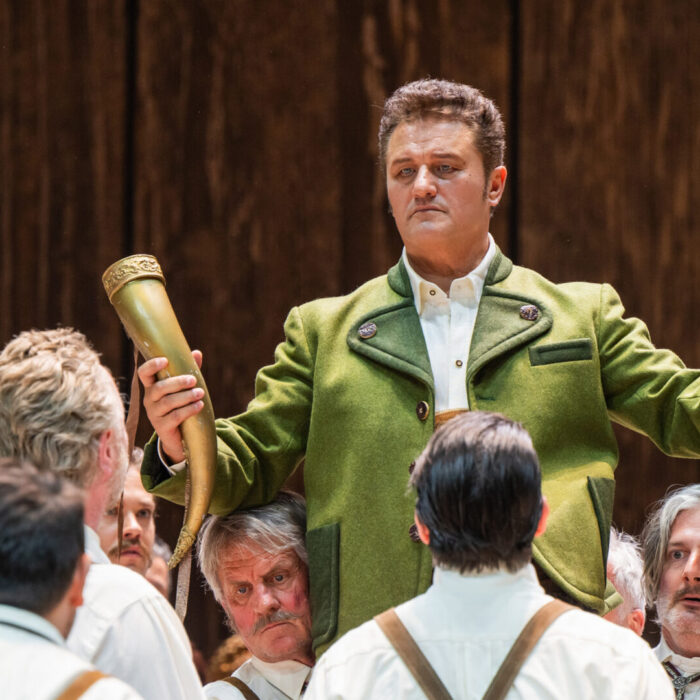
Teatro La Fenice 2018-19 Review: La Traviata
Claudia Pavone, Markus Werba & Stefan Pop Hit & Miss In Uneven Performance
By Alan NeilsonTeatro La Fenice certainly plays its part in making “La Traviata” the most oft-performed opera in the world. This season alone it will present 35 performances, with another 25 scheduled for next year. As in many houses, therefore, Verdi’s much loved opera forms part of the company’s staple repertoire. Obviously, an orchestra’s familiarity with a work may act as either a benefit or as a hindrance to a successful performance; the musicians may refine their understanding, allowing for a more insightful reading, or alternatively, they may become too casual and lack the necessary spontaneity to elevate the presentation beyond the routine. For this performance at La Fenice, the 27th of the season, neither extreme was the case, although elements of both were in evidence.
Unevenness Abounds
Under the direction of Sesto Quartrini, the Orchestra del Teatro La Fenice produced a largely satisfying, albeit uneven performance. Certainly, there was a consistently high level of technical proficiency and Quatrini elicited pleasing dynamic and rhythmic contrasts from the orchestra and maintained a good balance between all the musical forces. However, musically it did not always take wing. This was particularly noticeable in the first act, in which the orchestra must enter into the gay abandon of the onstage party if it is to fully convince. Unfortunately, for all its merits this was not the case, and there was a feeling that one was listening to a routine workaday delivery, which lacked the necessary sparkle and frisson, although to be fair this was compounded by the darkness of the set. Large parts of Acts two and three, however, were of a different quality. In Act two, scene two, the orchestra was fully engaged and produced exactly what was missing in Act one, the music wonderfully capturing the onstage party atmosphere as it bubbled and fizzed under Quatrini’s baton. In parts of Act three the music sensitively evoked the ethereal atmosphere, whilst generating the deep emotional anxieties that drive the scene towards its desperate ending.
In many ways the director, Robert Carsen, aided by Patrick Kinmonth (scenery and costumes) and Pete Van Praet (lighting) and Philippe Giraudeau (choreography) created a production which mirrored the musical performance; excellent in parts, less successful in others, but generally of a high standard with much to commend. Carsen’s main focus was on the role of money; how it underpinned Violetta’s lifestyle and social standing, and how it also shaped her future. Thus during the prelude, men entered Violetta’s bedroom to make her gifts of money, which she threw around with joyful abandon. In the final act, her lack of money meant she had not only been left to die in an impoverished, dilapidated house, but had also been abandoned by her army of admirers. It was a simple idea that was seamlessly integrated into the drama and successfully presented, and it did so without detracting from the opera’s other themes, such as the bourgeois hypocrisy which saturated Parisian society, and the fear that tuberculosis held over people during the 19th century.
The second act was undoubtedly the high point of the production, both scenes were imaginatively designed and created a wonderful contrast between Violetta’s two lives. Scene one was set outside, in the wooded garden of her country house; it was a peaceful setting in which, at the beginning, everything appears calm. However, the money falling like leaves from the branches suggested the oncoming storm. It made an excellent backdrop for Alfredo, Violetta, and Giorgio’s interactions. The second scene was set in what appeared to be an Art Deco ballroom, which transformed instantaneously into a nightclub; a screen lifted to reveal a stage, which was quickly filled with a dance troupe, dressed in revealing silver sequined cowboy and cowgirl costumes, who cavorted and gyrated seductively, as the well-heeled guests, seated around small tables, watched on and enjoyed the spectacle. It was colorful, energetic and exceptionally well choreographed. Following Alfredo’s private confrontation with Violetta, he mounts the stage and, in front of the guests, makes a great show of throwing money at Violetta, for services rendered. The entire act was brilliantly staged and perfectly focused; the dramatic turning points wonderfully highlighted against convincing and engaging backdrops.
Unfortunately, Acts one and three were not up to the same high standard, but for very different reasons. In Act one Carsen had Violetta’s bedroom double as a ballroom for the party. It was messy and did not really convince, although the choreography added the necessary energy to the scene. The main problem, however, was one of color – it was simply too dark, and failed to provide the necessary sparkle and glitz, and dimmed the necessary gaiety. Violetta’s red dress was just not enough. On the other hand, Carsen managed to capture the dark side of the proceedings, and having the doctor administer an injection to the ailing Violetta was a nice touch. The setting for Act three was also fairly dull. Violetta was living in the same house, which had now fallen into a state of disrepair, but for some reason she had the decorators in for some repainting. There was now no bed, so she had to make do with the floor, next to a television with a constantly flickering screen. Again there was a lack of color, which was understandable in this case, and the brutality of the room nicely reflected her situation, but it contained an aggressive edge which did not fit well; the offstage chorus of revelers was allowed to invade and trash her bedroom, paying little heed to the dying Violetta, and then later, immediately following her death, the painters arrive, ignore the dead body and focus on the job at hand. All of which, simply added an unnecessary ugly element and detracted from the poignancy of the scene.
Solid In Parts
The principal roles were undertaken by three accomplished singers, all of whom made excellent contributions. Violetta was interpreted by the soprano, Claudia Pavone. Her voice is strong across the range with a colorful pallet, which she used to good effect in delivering an emotionally expressive and passionate performance. In the opening to the duet “Ma se tornado non m’hai salvato” Violetta reflects upon her coming death, and upon the happiness she wanted so much, which is now so close, but that she will never see. Pavone produced an intense rendition in which she displayed her voice’s marvelous flexibility, evidenced by its colorful and dynamic contrasts, which she overlaid with impassioned inflections. Throughout Acts two and three she produced a consistently emotionally charged reading, and if she occasionally lacked a certain amount of beauty it was a price worth paying. In Act one, however, she was less effective – she appears to be more at ease in the heavy emotional scenes. In the opening party scene she sang well, but never managed to fully engage with the character. “Sempre libera” displayed her technically proficient coloratura, but the cabaletta lacked the necessary radiance and vitality. Overall, this was a compelling performance, one which highlighted Pavone’s skills as a singing-actress, and her ability to enter into the emotional heart of a character.
Outwards But Not Always Inwards
Stefan Pop is a naturally gifted singer, with a strong lyrical voice, who has the gift of making his singing seem so easy Notwithstanding a little too much vibrato on occasions, he is a delight to listen to, the voice lying easily on the ear. He is able to spin out long lines, which soar effortlessly upwards and bloom. The voice has a beautiful tonal quality which he uses to craft delightful phrases. He does, however, appear to sacrifice subtlety in characterization in favor of beauty, or for an earnest emotional display. His aria, “Oh mio rimorso! Oh, infamia!” in which sings of his shame of living off Violetta’s money was a strident heartfelt outpouring, which he directs towards the audience itself, rather than looking inwards and presenting it as a personal reflection of his inner anxiety. His costume, which consisted of black trousers and a dark shirt, was simply bland and added nothing whatsoever to the character, yet it did not dampen Pop’s clear enthusiasm for the stage, and his delight in performing in front of an audience.
Often Detached
The baritone, Markus Werba, in the role Giorgio Germont made an excellent impression, although his distant and unemotional relationship with Violetta was possibly taken a little too far. Dressed smartly in an insipid double-breasted suit, with studious glasses and graying hair, he was the epitome of self-contented hypocrisy. Having been clearly directed to remain aloof, his acting at times became exaggeratedly wooden and too detached. Vocally, however, he was far more secure. He possesses a strong voice with a rich warm timbre, that loses none of its quality or beauty as he moves between the registers. He sings with intelligence, phrases his lines with care, and is able to capture the emotional nuances of the character. The extended duet, with Violetta, at the center of Act two, scene one, starting with “Ah! dite alla giovine,” was powerfully delivered. Werba remained physically distant, but vocally, the nuanced accents and subtle shadings conveyed the thaw that was starting to take place in his heart. As the duet continues with, “Morrò! La mia memoria” however, it is clear that Germont remains steadfast. Werba brilliantly portrayed his position as he wavered between insistence and genuine remorse, his voice at times strident, at times imploring, at times tinged with sadness. If there was one criticism to be made, it was that there was a notable Germanic edge to his articulation.
The minor roles were all despatched well, with the soprano Sabrina Vianello as Annina, the bass-baritone, William Corrò as Baron Douphol and the bass, Francesco Milanese as Doctor Grenvil making notable contributions. The Coro del Teatro La Fenice under the direction of the chorus master, Claudio Marino Moretti, was in excellent form, delivering an energetic performance that added some much-needed fizz to the party scenes, especially in Act one.
Overall, this was a very good production, if flawed in parts, although it suffered slightly from being overperformed; 35 in a single season is a lot, and the spontaneity and freshness which are so important for a successful staging, although not absent, were somewhat diminished.


